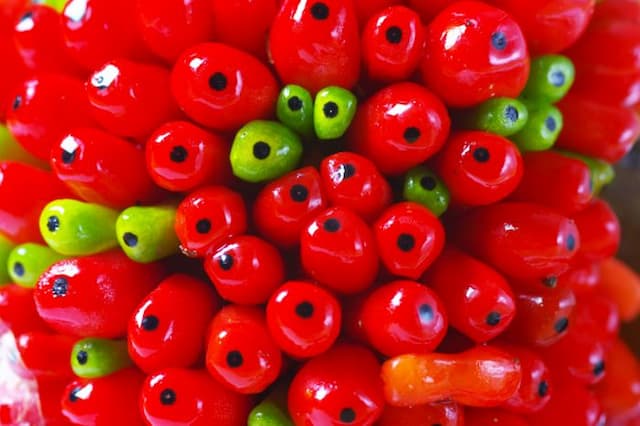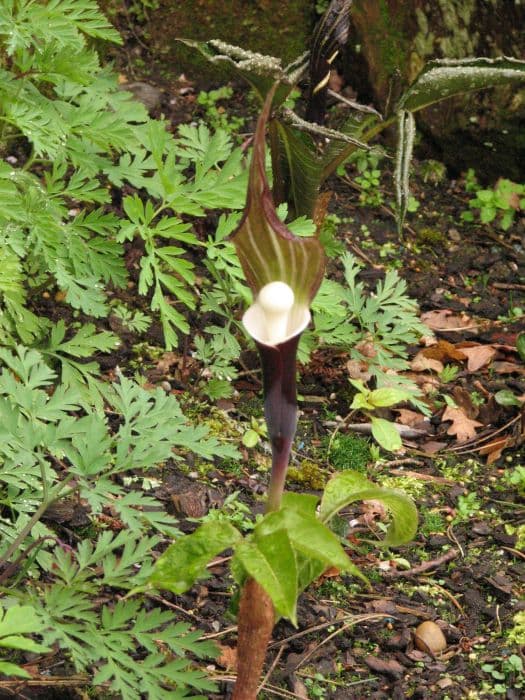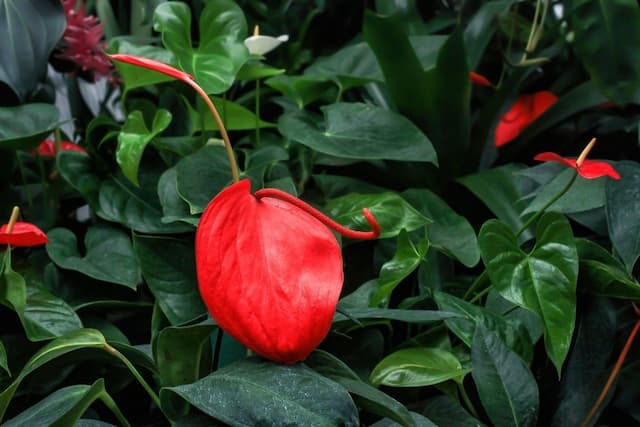White skunk cabbage Lysichiton camtschatcensis

ABOUT
Commonly known as white skunk cabbage, this perennial plant is native to wet, boggy areas and features striking characteristics. It possesses a large, waxy, creamy-white spathe that wraps around a spadix, which is a spike of small, closely packed flowers. The spathe is often hooded or pitcher-shaped, creating an alluring visual contrast with the surrounding green foliage. The leaves are broad, glossy, and have a robust, hearty appearance, emerging from the base of the plant. These leaves unfurl as they mature, adding to the lush, verdant backdrop against which the distinctive spathes stand out. This plant typically blooms in the early spring, presenting a fascinating spectacle as the flowers emerge before the canopy of the forest fully develops. Overall, the white skunk cabbage's striking flower structure and vibrant leaves create a noteworthy presence in its natural habitat.
About this plant
 Names
NamesFamily
Araceae
Synonyms
White Skunk Cabbage, Asian Skunk Cabbage, Japanese Skunk Cabbage
Common names
Lysichiton camtschatcense, Lysichitum camtschatcense, Orontium camtschaticum, Pothos kamtschaticus, Lysichiton album, Lysichiton camtschatcense var. album
 Toxicity
ToxicityTo humans
The plant commonly known as white skunk cabbage contains calcium oxalate crystals which can cause irritation. If ingested, parts of this plant can lead to symptoms such as a burning sensation in the mouth and throat, difficulty swallowing, and stomach upset. In severe cases, swelling can occur which may lead to difficulty breathing.
To pets
White skunk cabbage is also toxic to pets due to the presence of calcium oxalate crystals. Consumption can result in drooling, pawing at the mouth, oral pain, decreased appetite, and vomiting. If a pet ingests this plant, it is crucial to seek veterinary attention as the symptoms can escalate and cause severe discomfort or more serious complications.
 Characteristics
CharacteristicsLife cycle
Perennials
Foliage type
Evergreen
Color of leaves
Green
Flower color
White
Height
1-2 feet (30-60 cm)
Spread
1-2 feet (30-60 cm)
Plant type
Herb
Hardiness zones
5
Native area
Asia
Benefits
 General Benefits
General Benefits- Ornamental Value: Lysichiton camtschatcensis, commonly known as Asian skunk cabbage, has a unique appearance that adds an exotic touch to water gardens and boggy areas.
- Wildlife Habitat: Its large leaves and flowers provide shelter and habitat for various species of insects and small animals.
- Pollinator Attraction: The flowers produce a strong smell that attracts pollinators, benefiting the local ecosystem's pollination processes.
- Wetland Indication: Asian skunk cabbage can indicate the presence of wetlands, which are crucial for environmental conservation efforts.
- Erosion Control: The root system of Lysichiton camtschatcensis helps stabilize soil in wet areas, reducing erosion and improving water quality.
- Educational Value: This plant is a unique example of bog and wetland flora and can be used for educational purposes in botanical gardens and nature programs.
 Medical Properties
Medical PropertiesThis plant is not used for medical purposes.
 Air-purifying Qualities
Air-purifying QualitiesThis plant is not specifically known for air purifying qualities.
 Other Uses
Other Uses- Lysichiton camtschatcensis, commonly known as Asian skunk cabbage, can be used in ornamental water gardens for its striking foliage and unusual flowers that add aesthetic value to the setting.
- In crafting, the large leaves of the Asian skunk cabbage can be used as natural wrapping material for small gifts or bouquets, providing a unique and eco-friendly packaging option.
- Asian skunk cabbage can serve as a learning tool in botanical education programs, showcasing the plant's adaptations to wetland ecosystems and its role in those environments.
- The robust nature of Asian skunk cabbage makes it suitable for use in soil erosion control projects, especially along stream banks and other wet areas where it can help to stabilize the soil with its roots.
- In landscape photography, the striking appearance of Asian skunk cabbage during its flowering period can be utilized as a subject to create visually interesting and dynamic photographs.
- Asian skunk cabbage can be used in natural dye-making processes, where the plant's parts might offer varying hues for dyeing fabrics or materials, although further research into specific colors and methods is needed.
- As a form of natural insect control, the plant may potentially attract and trap certain types of insects, although its efficacy and specificity would require scientific investigation.
- For culinary experimentation, although not commonly eaten due to potential toxicity, some cultures have historically consumed parts of the plant that were properly processed to remove harmful components.
- Asian skunk cabbage might serve as a subject for botanical artists and illustrators who focus on rendering detailed and scientifically accurate representations of unique plant species.
- The plant’s characteristic odor can be used in sensory gardens that aim to provide a full range of olfactory experiences, although it should be used judiciously due to its pungency.
Interesting Facts
 Feng Shui
Feng ShuiThe Skunk Cabbage is not used in Feng Shui practice.
 Zodiac Sign Compitability
Zodiac Sign CompitabilityThe Skunk Cabbage is not used in astrology practice.
 Plant Symbolism
Plant Symbolism- Purity: Lysichiton camtschatcensis, commonly known as Asian skunk cabbage, is often associated with purity due to its bright, pristine white spathe, which is reminiscent of cleanliness and innocence.
- Attention-grabbing: The plant's distinctive and somewhat overpowering odor can symbolize the need to be noticed or the ability to stand out in a crowd.
- Adaptability: Asian skunk cabbage thrives in swampy, wet conditions, suggesting the ability to adapt and flourish even in challenging environments.
- Protection: The large leaves of Lysichiton camtschatcensis can be seen as a symbol of shelter and protection, enveloping and guarding smaller plants or animals in their natural habitat.
- Awakening: As one of the first plants to bloom in spring, it can also be symbolic of rebirth or awakening after a period of dormancy or quietude.
 Water
WaterThe White Skunk Cabbage requires consistent moisture and should be watered thoroughly to keep the soil evenly damp. During the growing season in spring and summer, water it with about 1 to 2 gallons per week depending on the weather conditions, ensuring you increase watering if there are extended periods of dryness or heat. In the fall and winter, reduce watering slightly but do not allow the soil to completely dry out. Make sure the plant has well-draining soil to prevent waterlogging, which can lead to root rot.
 Light
LightWhite Skunk Cabbage thrives in partial shade to full shade. The ideal spot for this plant is one that mimics its natural habitat, such as under a canopy of deciduous trees where it can receive filtered sunlight. Direct sunlight, especially in hot summer climates, should be avoided to prevent scorching the leaves.
 Temperature
TemperatureWhite Skunk Cabbage is hardy and can withstand a range of temperatures. It prefers cooler conditions and can survive in temperatures as low as 20°F. The plant's ideal temperature range is between 60°F and 75°F, but it can tolerate temperatures up to 90°F if adequate shade and moisture are provided.
 Pruning
PruningPruning White Skunk Cabbage is not typically required as the plant is self-maintaining. However, if you need to remove dead or damaged leaves, do so in the late fall or early spring. Pruning should be minimal, focusing on maintaining the natural shape of the plant and preventing overcrowding. The best time for any necessary pruning is after the plant has died back and before new growth starts.
 Cleaning
CleaningAs needed
 Soil
SoilThe Asian skunk cabbage thrives in moist, organically rich soil with a pH range of 5.5 to 7.0. It is best to mix peat, loamy soil, and some sand to ensure good drainage and aeration. Additionally, maintaining a consistently moist soil condition is crucial to mimic its natural boggy habitat.
 Repotting
RepottingThe Asian skunk cabbage does not require frequent repotting and should generally be repotted every 2-3 years or when it outgrows its current container. It is typically done in the spring before the new growth starts.
 Humidity & Misting
Humidity & MistingAsian skunk cabbage prefers high humidity levels, typically between 60-80%. It thrives in conditions that replicate its natural humid, boggy habitats, making it a plant well-suited for environments close to water bodies or in a consistently moist area of a garden.
 Suitable locations
Suitable locationsIndoor
Provide moist soil, indirect light, and cool temperatures for Asian skunk cabbage.
Outdoor
Plant in partial shade, moist soil, and protect from strong winds for Asian skunk cabbage.
Hardiness zone
4-8 USDA
 Life cycle
Life cycleLysichiton camtschatcensis, commonly known as white skunk cabbage, begins its life cycle as a seed, typically dispersed by water or animals. After germinating in moist soil, the seedling develops into a juvenile plant with a rosette of basal leaves. As it matures, the plant forms a rhizome underground, which serves as an energy reserve and allows for vegetative reproduction. Each spring, the white skunk cabbage produces a distinctive flowering spadix surrounded by a white spathe, which attracts pollinators and subsequently forms berry-like fruits containing seeds. Following pollination and seed set, the plant enters a period of senescence where the leaves die back, and the plant relies on its rhizome for survival through the winter. The cycle repeats annually, with the plant potentially living for many years and gradually forming colonies through clonal expansion.
 Propogation
PropogationPropogation time
Spring
Propogation: The most popular method of propagating Lysichiton camtschatcensis, commonly known as Asian skunk cabbage, is by division. This is typically done in late autumn or early spring when the plant is dormant. The process involves carefully digging up the clump of the plant and gently separating the rhizomes, making sure each section has at least one growth point. These divisions can then be replanted in moist, rich soil at a depth of about 2 to 4 inches (5 to 10 centimeters), spaced approximately 12 to 24 inches (30 to 60 centimeters) apart to allow for growth. It is important to keep the soil consistently moist but not waterlogged, as Asian skunk cabbage thrives in wet conditions similar to its natural boggy habitats.









